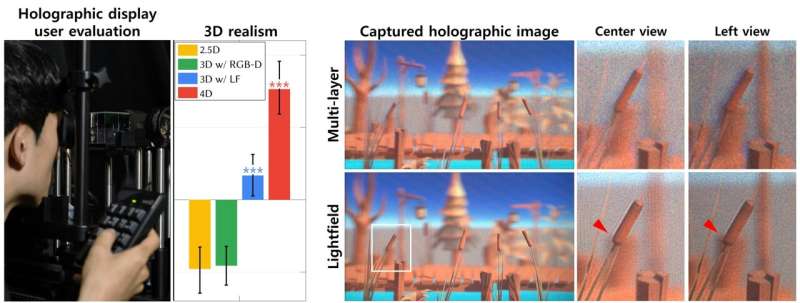This article has been reviewed according to Science X's editorial process and policies. Editors have highlighted the following attributes while ensuring the content's credibility:
fact-checked
peer-reviewed publication
proofread
Research team identifies key visual perceptual factors for enhancing 3D display realism

A research team has identified key visual perceptual factors that enhance the viewing experience of 3D displays.
The research revealed that the presence of parallax significantly impacts the perceived realism and immersion of 3D images viewed through holographic displays.
The results of this study were published in ACM Transactions on Graphics on July 19, and were presented at the international conference on computer graphics, SIGGRAPH 2024, held in Denver from July 28 to August 1.
Holographic displays, considered the next-generation 3D display technology, generate 3D images by using coherent light sources, such as lasers, and spatial light modulators that reconstruct digitally computed holograms. For 3D image representation in holographic displays, a method for expressing depth is required.
Traditionally, a multilayer approach, which divides the object into multiple layers, has been used. While this approach produced high-quality images when captured on camera, it lacked sufficient user evaluation regarding the realism of the viewing experience.
Focusing on this issue, the research team analyzed which 3D image representation methods offer better user experiences when viewed through holographic displays. They specifically investigated parallax as a key visual perceptual factor that adds a sense of realism to the viewing experience.
Parallax refers to the perceived speed variation of an object based on its distance from the viewer, where objects farther away appear to move more slowly. Incorporating this effect in 3D displays enhances the depth perception and realism of the image. However, the multilayer method struggled to accurately reproduce this effect.
With this in mind, the research focused on comparing the user experience of 3D images generated by the light field method, which accurately represents parallax, and the traditional multilayer method. By analyzing user evaluations of 3D images generated by both methods and viewed through holographic displays, the research team confirmed that 3D images using the light field method were preferred over those using the multilayer method.
The research team explained, "This discovery is a groundbreaking finding that can be used to maximize the immersion offered by next-generation 3D displays." They added, "It is expected to make a significant contribution to addressing the limitations of immersion and realism in virtual reality (VR) and augmented reality (AR) 3D viewing experiences."
The Optical Engineering and Quantum Electronics Laboratory, where the research was conducted, is currently led by Prof. Yoonchan Jeong following the passing of Prof. Byoungho Lee in November 2022.
The lab continues its active research in 3D displays, holography, and metasurfaces. Stanford University's Computational Imaging Lab, which collaborated on this research, is currently led by Gordon Wetzstein, an expert in spatial computing.
More information: Dongyeon Kim et al, Holographic Parallax Improves 3D Perceptual Realism, ACM Transactions on Graphics (2024). DOI: 10.1145/3658168


















